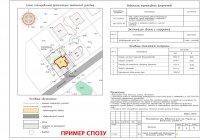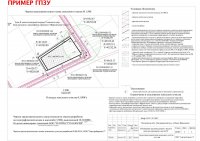Construction Of An Individual Housing Unit

Articles:
How to prepare for the building?
The construction of a dwelling can only take place when the construction permit (reconstruction) is obtained from the administration of the land area.
This article provides sufficient details of actions to obtain the authorization and preparation of the documents that will be required to address the construction of housing units at the PWC and LPC sites, which are also relevant to the construction of housing units in the farms (CFCs).
The sub-section on the construction of houses in the day-to-day areas is particularly specific, as this would not require authorization.
The article was extensive because it provided clarification of the substance of the documents, their content, references to legislation, examples of documents and statements presented in the right column.
However, the summary of the material presented would still welcome the site builders to achieve the main objective of obtaining a building permit, with full understanding of the material to be submitted to the administration.
Now, get patience and meet you.
What's a building permit?
The RF (No. 190-FZ), which is in force, has established a simplified procedure for obtaining a permit for the construction or reconstruction of an individual housing facility, a separate house with no more than 3 floors for one family (art. 48, para. 3).
Construction permit - This document confirms the conformity of the project documents with the requirements of the construction plan of the land area and gives the developer the right to build, reconstruct individual capital construction facilities and repair capital.
Construction permits are not permitted in the absence of land use and construction regulations (LTAs).
In the absence of ELVs, construction permits are issued for:
- construction, reconstruction of federal facilities
- Regional objects,
- Local municipality sites
- Construction facilities on land that are not subject to urban regulations or for which urban regulations are not established,
- in other federal cases.
The basis for the preparation of a package of documents and the granting of construction permits (reconstruction) of an individual residential house, in accordance with the landowner ' s statement, is the RF Gravity Code (art. 51, para. 9).
Documents for authorization
In order to obtain a permit for the construction of an individual housing unit, the following documents shall be written by the owner(s) of the plot to the administration of the area (in the architectural office):
- land title documents (ownership certificate or lease right and land cadastral passport);
- The consent of all right holders of the capital construction site in the event of the renovation of an individual housing unit, with the application of the right-wing documents for a dwelling;
- ID of the developer.
- Project documentation, if desired by the developer.
No other documents are required to obtain a building permit from the developer of the FAZ facility (art. 51, para. 10).
What does the administration check when they get the documents?
The construction permit shall be issued within 10 days of the application by the developer with the documents listed above.
During this period, the availability of documents attached to the application shall be verified, the conformity of the project documents or the planning structure of the land area shall be checked, with the identification of the location of the site of the individual housing construction site to the requirements of the plot ' s construction plan and the red lines.
The developer may request permission to deviate from the limits of the permitted construction or reconstruction. In this case, the project documents or the plot of land planning are checked to meet the requirements of the construction permit.
 Issue or refuse to grant permission for rejection, specifying the reasons for refusal.
Issue or refuse to grant permission for rejection, specifying the reasons for refusal.
The refusal to grant a building permit may be challenged by the developer in court.
The term of the permit for the construction of an individual dwelling is 10 years.
What does the building permit confirm?
According to article 51 of the RF Civil Code, construction permit:
- Affirms the conformity of the project documents with the requirements of the land planning plan and, in the absence of a urban plan, with the permitted use of the site;
- gives the developer the right to build, reconstruct real property and repair capital.
If the previous owner of the site has already obtained a construction permit and the ten-year period has not expired, the new owner should not be re-approved - it is not tied to a particular person but applies to the site as a whole, except in individual cases.
Even if the site is to sell a plot whose construction permit is not yet valid, the permit is retained for the future owner.
Construction permit received. What's next?
Upon receipt of the building permit, the developer is required to provide, within 10 days, free of charge to the authority issuing the building permit (management architecture):
- the height and floors of the planned capital construction site;
- Engineering networks (technical conditions for connection);
- Sections of the project documentation or planning scheme of the land area, with the identification of the location of the site of the individual housing construction site, in accordance with article 48, paragraph 2, 8, 9, 10, of the RF Code.
This information is included in the urban information system.
Is there a requirement or no permit for the construction of dwellings built at gardens?
No, you don't. Why? - Because the local government of the region approves the design of the Territory (PPT) of the entire long-term association (normal association), which is a legal instrument.
According to this project, the organization of the Territory of the Day Association is under way. The Local Government Administration approves all project deviations.
 The horticultural products (goods associations) include the general land area of horticulture or NPD, NT, which includes public land - roads, streets, passages, fire-fighting waters, areas and areas of public use, including health-protection areas, and the land of individual areas - the immediate land.
The horticultural products (goods associations) include the general land area of horticulture or NPD, NT, which includes public land - roads, streets, passages, fire-fighting waters, areas and areas of public use, including health-protection areas, and the land of individual areas - the immediate land.
Constructions, consisting of long-term homes, garages and economic structures, are being built by the owners of these sites.
No construction permit is required for the construction of gift houses on land for horticulture or long-term farming (art. 51, para. 17).
Special attention should be paid to the fact that the gear should be located in the area specifically allocated for the construction of the day.
Otherwise, if the house is built, for example in the general horticulture area, the existence of a building permit will be obligatory - without it the owner of the house may be charged with self-built construction.
When no building permit is required?
The construction permit is not required for the LHS, LPH, horticulture and long-term land for the following tasks:
- garage construction;
- Construction, reconstruction of non-capital construction facilities (e.g. suspensions, etc.);
- Construction of buildings and support facilities;
- Changes to and/or parts of capital construction facilities, if such changes do not affect the design and other characteristics of the facility (sustainability, safety, limit values of authorized construction or reconstruction established by the construction regulations.
- major repairs to capital construction.
- Other cases provided for in the RPF Code.
The construction permit is preceded by the preparation of a GLP. What is this?
The land plot (GLP) is the type of land planning documentation.
Implemented by the RF Greed Code (N 190-FZ) in lieu of architectural tasks and authorization letters from district and city committees (divisions) on urban planning and architecture (P.2, art. 44, RF Code).
The introduction of such a document has moved most of the agreements to the pre-project stage.
The land boundary plan is used to develop project documentation, develop the boundaries of the site to be built (or built) and subsequently to permit the construction and commissioning of the site.
This is one of the main documents that the developer or customer (physical and legal person) is required to provide to the project organization for the preparation of a project decision under a contract with the developer or the customer.
The GPA is the basis for the implementation of the project decisions on the construction and renovation of capital construction facilities, in this case under this heading, of individual housing units.
Gradplan (GHLP) is prepared by the District Architecture Unit. Issued on the basis of a statement by the developer (physical or legal person).
A separate order of the district (urban) administration is approved.
Under the law, the issuance of a land plot is free of charge to the applicant and takes place within 30 days of the receipt of the application.
 The HDR is being developed for a separate land area for which a State cadastral register has been made, and urban regulations are set in the building regulations. The HDR shall be carried out either as part of the internet project or as a separate document.
The HDR is being developed for a separate land area for which a State cadastral register has been made, and urban regulations are set in the building regulations. The HDR shall be carried out either as part of the internet project or as a separate document.
The GPA describes the planning of the territory of built and planned land, as well as the capital construction facilities to be refurbished (except linear facilities).
What does the GHTA contain?
The urban plan provides the following information:
- The cadastral number of the land under review and, where available, the cadastral numbers of buildings and structures at the site;
- The legal form and name of the applicant (for a legal person) or surname, name, father (for an individual);
- Limits and sizes of the land area: determined according to the red lines, the boundaries of adjacent land (if any), the natural boundaries of the land area;
- Areas of operation of public easements located on the land;
- Minimum deviations outside the land area to indicate the possible location of buildings, buildings and structures outside the land area;
- Information from the Land and Construction Regulations (LTA) on the permitted uses of the land area;
- Information on the urban regulations of the land area, if the site is subject to the urban regulations, with information on all the land permitted use;
- If the site is not subject to the construction regulations or the construction regulations for it, the permitted use of the land area and the requirements for parameters, location and designation of the construction site on the site shall be indicated;
- Information on cultural sites as well as capital facilities located in the land area;
- Other restrictions placed on the land;
- information on workloads or contracts awarded Engineering The land area and the technical features of the connection of capital construction projects located in the land area to engineering networks;
- the boundaries of the planned capital construction site for public and municipal needs;
- information on the possible or impossibility of dividing it into several land areas may be included in the GPA.
Description:
1. Tertiary rules - This is established in accordance with the land use and construction (LTA) regulations within the territorial boundaries:
- Types of permitted use of land and capital construction facilities (e.g. housing, trade, business and commercial facilities, industrial enterprises, warehouses, etc.);
- limit (minimum and/or maximum) size of land;
- Limit values for permitted construction, refurbishment of capital construction facilities (e.g. floor and density of construction);
- Minimum permissible derogations (removals) from buildings walls to land and red lines;
- Minimum percentage of green land;
- Restrictions on the use of land and capital facilities.
2 is the diagram of the fence line around the section that separates the land from the street or from the road.
The house or other housing shall be:
- from the red line of the streets at least 5 m
- from the red line of travel at least 3 m.
- The distance from economic construction to the red line of streets and passages shall be at least 5 m.
3. The following types of permitted use should be available for the construction of an individual housing unit at land:
- for individual housing (SW);
- for personal household (LPH) with the right to establish an individual dwelling.
To get a GHTA, you need to prepare a PHOSE.
The land plot planning system (LPD) is a construction site and existing (if available) communications to the land. Changed the old land plot master plan.
SPES is a material of an M1-500 topography with underground communication (if any) to which it is carried,
- the land boundary in accordance with the law-enforcement documents, existing capital construction facilities,
- supernatural
- Facilities for future construction.
The PPE in the construction of the LHS facility shall be in accordance with the HDR.
The land plot planning scheme consists of:
- land development plan number
- Land area.
- percentage of construction (with attached calculation).
- Total housing area.
- number of ground floors. The height of the building.
- The type of fence.
- The composition of the individual housing facility.
- Symbols.
The land plot planning scheme is approved by the administration (the city and architecture division).
A PESO is required to be ordered by a licensed project organization with a certificate of registration in self-regulated organizations (SSRs), with the necessary documents:
- Application for the preparation of the PEP land area in the prescribed form;
- An approved and registered land development plan (GDP) for the construction of an individual home facility;
- Copies of land title documents (ownership certificate or lease contract, land use contract, land use act);
- Copies of land cadastral passports and, where available, buildings, buildings, constructions, constructions, construction projects located on the land area, or copies of technical passports of buildings (constructions) located on the land area, with an exhibition and land plan;
- Geo-substantiation or topography with the boundaries of the designated area (if any);
- House sketch project (if any);
- A copy of the inter-agency case (if any).
When can we start construction?
Once a permit has been obtained for the construction or reconstruction of a dwelling on the land for personal construction or personal support with the construction of a dwelling, construction can take place.
Once construction is completed, the construction should be commissioned.
Summary
So to get a building permit, you need to:
- Collect land documents and verify their validity;
- In the Architecture Department, order a HDR;
- Seek to the project organization and, through the submission of the GHTA, to prepare a PESA;
- The documents for the site, the GLP and the PPE prepared to be submitted to the Architecture Office for a building permit.
That's it. It's cheap and hearty, as they say. And then the most interesting thing is building your dream house.
Launch
The document that will verify the construction or renovation of the facility in full scope and in accordance with the permit for the construction and construction plan of the land area (GLM) as well as the project documentation (PPP) is the authorization for the installation of the FDL facility (article 55 of the RPF Code).
The authorization to install the FAZ facility shall be free of charge.
In order to be authorized to enter into service, the following documents should be addressed to the Administration (Army of Architect), which issued a building permit, with the relevant statement and annex:
- land titles;
- Urban Land Plan (GDP);
- Construction permit;
- A document confirming the conformity of the capital construction facility to the requirements of the technical regulations and signed by the construction worker;
- Documents confirming the conformity of the facility with the technical conditions (ST) and signed by representatives of organizations operating the engineering networks (if any);
- The structure of the built house, the location of engineering networks at the land boundary and the land plot planning scheme (LPD);
- Cadastral passport of the individual housing facility. (required in BTI);
- Authorization for the commissioning of an LHS facility.
It is understandable that, once the house is in operation, it needs to be registered - a certificate of ownership.
An unfinished construction site could also be registered at 70 per cent of its readiness, i.e. not operational. It's not gonna work out that way.
Postal address
The postal address of the built house is assigned by the local government (administrative). To that end, a written statement should be submitted and the following documents attached:
- Certificate of ownership of land;
- Construction and operation permits;
- BTI cadastral passport on home (texport);
- Others, at the request of the Administration.
It's useful to see that.
On 1 March 2015, the new Federal Act amending the Land Code of the Russian Federation and certain statutes of the Russian Federation (N 171-FZ) came into force, which, inter alia, simplified the procedure for the purchase of land from municipalities.
As of 1 January 2018, the cadastral passport should contain precise boundaries of the plots, as it would be impossible to buy, sell, mortgage or give land without a precise description of the boundaries. This is regulated by amendments to the Land Code. The total border audit, initiated by municipalities, began on 1 June 2015.
Documents
Example of SPEP
Example of GTA
Related posts:
 The owner does not always have the opportunity to build a house on his own accord. The establishment of housing units must be regulated by the authorities, which…
The owner does not always have the opportunity to build a house on his own accord. The establishment of housing units must be regulated by the authorities, which… The SVC, Stream Dom, provides all the services immediately, from the design of a house or a cottage project to the building of a house or the construction of a cottage…
The SVC, Stream Dom, provides all the services immediately, from the design of a house or a cottage project to the building of a house or the construction of a cottage… If you re going to build your own country house, you re sure you know that before any work is done, it s necessary to define the project. You can create a home project…
If you re going to build your own country house, you re sure you know that before any work is done, it s necessary to define the project. You can create a home project… Engineering networks and communication are used in each house. People need water, heat, sewerage, electricity for comfort. Engineering networks comprise three types…
Engineering networks and communication are used in each house. People need water, heat, sewerage, electricity for comfort. Engineering networks comprise three types… For more than 11 years, we have been building wooden houses from the Brew in Ekaterinburg and guaranteeing an optimal price-quality ratio: we are building houses…
For more than 11 years, we have been building wooden houses from the Brew in Ekaterinburg and guaranteeing an optimal price-quality ratio: we are building houses… In the modern construction market, houses and new technology facilities in the construction of Genesis have been built for a year. The foundation of the buildings…
In the modern construction market, houses and new technology facilities in the construction of Genesis have been built for a year. The foundation of the buildings… House construction business is a very promising area. By selecting the most demanded specialization and organizing the firm properly, you will be able to get paid…
House construction business is a very promising area. By selecting the most demanded specialization and organizing the firm properly, you will be able to get paid… The Order of the General and Political Department of the Far North of the NKVD of the USSR for the development of the polygraphic base and the streamlining of the…
The Order of the General and Political Department of the Far North of the NKVD of the USSR for the development of the polygraphic base and the streamlining of the… Our company, LSTCroyGrup, is offering you ready projects based on the LSTC carcas. If you are not prepared to develop and develop a fully future development on your…
Our company, LSTCroyGrup, is offering you ready projects based on the LSTC carcas. If you are not prepared to develop and develop a fully future development on your… The Lad House has been building carcass houses in Irkutsk for over five years. As we use an integrated approach in construction, we are able to significantly reduce…
The Lad House has been building carcass houses in Irkutsk for over five years. As we use an integrated approach in construction, we are able to significantly reduce…